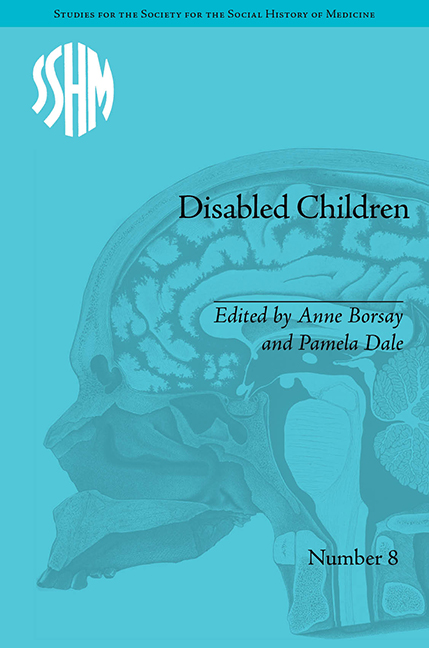Book contents
- Frontmatter
- Contents
- Acknowledgements
- Notes on Contributors
- Introduction: Disabled Children – Contested Caring
- 1 Club Feet and Charity: Children at the House of Charity, Soho, 1848–1914
- 2 Insanity, Family and Community in Late-Victorian Britain
- 3 The Mixed Economy of Welfare and the Care of Sick and Disabled Children in the South Wales Coalfield, c. 1850–1950
- 4 The Question of Oralism and the Experiences of Deaf Children, 1880–1914
- 5 Exploring Patient Experience in an Australian Institution for Children with Learning Disabilities, 1887–1933
- 6 From Representation to Experience: Disability in the British Advice Literature for Parents, 1890–1980
- 7 Treating Children with Non-Pulmonary Tuberculosis in Sweden: Apelviken, c. 1900–30
- 8 Health Visiting and Disability Issues in England before 1948
- 9 Spanish Health Services and Polio Epidemics in the Twentieth Century: The ‘Discovery’ of a New Group of Disabled People, 1920–70
- 10 Cured by Kindness? Child Guidance Services during the Second World War
- 11 Education, Training and Social Competence: Special Education in Glasgow since 1945
- 12 Hyperactivity and American History, 1957–Present: Challenges to and Opportunities for Understanding
- Notes
- Index
8 - Health Visiting and Disability Issues in England before 1948
- Frontmatter
- Contents
- Acknowledgements
- Notes on Contributors
- Introduction: Disabled Children – Contested Caring
- 1 Club Feet and Charity: Children at the House of Charity, Soho, 1848–1914
- 2 Insanity, Family and Community in Late-Victorian Britain
- 3 The Mixed Economy of Welfare and the Care of Sick and Disabled Children in the South Wales Coalfield, c. 1850–1950
- 4 The Question of Oralism and the Experiences of Deaf Children, 1880–1914
- 5 Exploring Patient Experience in an Australian Institution for Children with Learning Disabilities, 1887–1933
- 6 From Representation to Experience: Disability in the British Advice Literature for Parents, 1890–1980
- 7 Treating Children with Non-Pulmonary Tuberculosis in Sweden: Apelviken, c. 1900–30
- 8 Health Visiting and Disability Issues in England before 1948
- 9 Spanish Health Services and Polio Epidemics in the Twentieth Century: The ‘Discovery’ of a New Group of Disabled People, 1920–70
- 10 Cured by Kindness? Child Guidance Services during the Second World War
- 11 Education, Training and Social Competence: Special Education in Glasgow since 1945
- 12 Hyperactivity and American History, 1957–Present: Challenges to and Opportunities for Understanding
- Notes
- Index
Summary
Introduction
At the start of the twentieth century the development of services for disabled children in the United Kingdom accelerated and changed in a number of significant ways. Firstly, there was simply more provision as local councils gradually acquired permissive powers to develop (independently and in partnership with voluntary sector organizations) both specialist services for children and other health and welfare services accessible to people of all ages and utilized by disabled children and their families. Secondly, the new services were not just designed to respond to expressed need; they actively sought clients. This contrasted with the exclusive admissions policies designed to limit access to nineteenth-century residential special schools run by charities and the deterrent principles of the Poor Law. Thirdly, there was a shift away from traditional forms of institutional care to a more complicated network of services delivered in a variety of settings.
These developments have been explored through histories of the school medical service in England and Wales, which draw attention to the importance of establishing both regular medical inspections for school-age children and a number of clinics to diagnose and treat various disabling conditions. Although it has not been a strong theme in the historiography these clinics often worked in close partnership with other local authority services targeted at younger children, and also designed to identify, treat and crucially prevent childhood disability.
- Type
- Chapter
- Information
- Disabled ChildrenContested Caring, 1850–1979, pp. 117 - 130Publisher: Pickering & ChattoFirst published in: 2014



